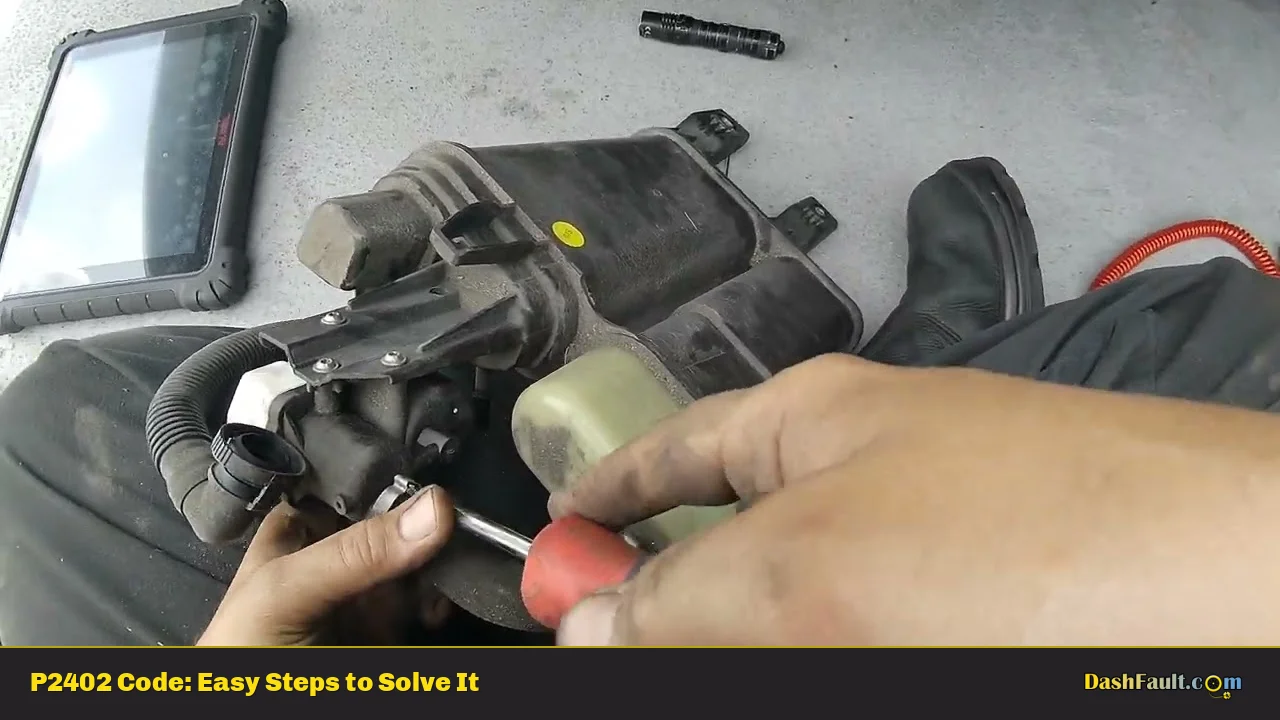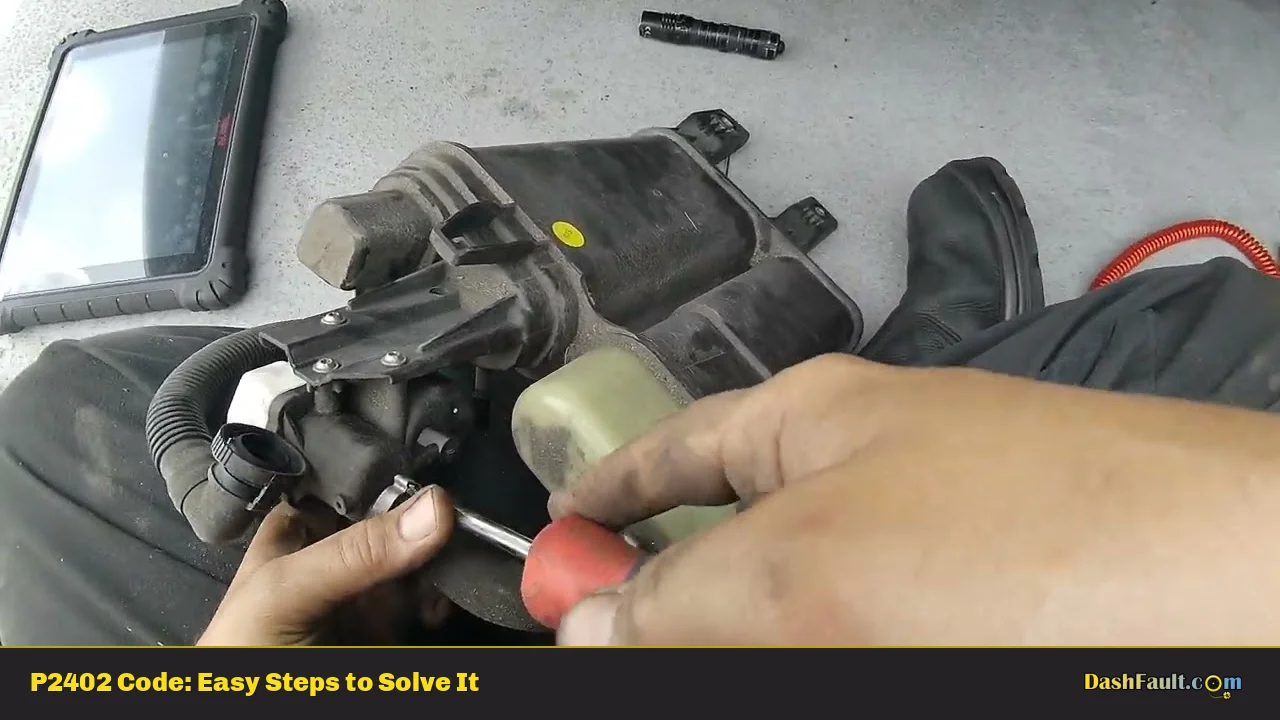The P2402 trouble code is a diagnostic indicator that points to an issue with the Evaporative Emission System (EVAP) Leak Detection Pump Control Circuit. When this code appears, it typically means that the vehicle’s Engine Control Module (ECM) has detected a higher than normal voltage in the circuit controlling the EVAP leak detection pump. This pump plays a crucial role in maintaining the integrity of the vehicle’s emissions system by creating a vacuum to test for leaks in the fuel vapor recovery system.
| P2402 Code Meaning | P2402 Code Common Causes |
|---|---|
| EVAP Leak Detection Pump Control Circuit High | Faulty EVAP leak detection pump |
| Excessive voltage in pump control circuit | Damaged wiring or connectors |
| ECM detects abnormal electrical behavior | Corroded or loose electrical connections |
| Potential emissions system malfunction | Malfunctioning ECM or PCM |
| Indicates need for EVAP system diagnosis | Blown fuse or faulty relay |
Understanding the EVAP System and P2402 Code
The Evaporative Emission Control (EVAP) system is designed to prevent fuel vapors from escaping into the atmosphere. The leak detection pump is a critical component of this system, creating pressure or vacuum to test for leaks. When the P2402 code is triggered, it indicates that the electrical circuit controlling this pump is experiencing higher than normal voltage levels.
Symptoms of P2402 Code
While the P2402 code primarily affects the emissions system, it can manifest in various ways:
- Illuminated Check Engine Light (CEL)
- Failed emissions test
- Slight decrease in fuel efficiency
- Occasional difficulty starting the engine
- Fuel odor, especially near the rear of the vehicle
In many cases, drivers may not notice any significant changes in vehicle performance, as the issue is primarily related to the emissions control system.
Technical Explanation of P2402
The P2402 code specifically relates to the control circuit of the EVAP leak detection pump. This circuit is responsible for supplying power and control signals to the pump. When the Engine Control Module (ECM) or Powertrain Control Module (PCM) detects a voltage in this circuit that exceeds the manufacturer’s specified threshold, it triggers the P2402 code.
The high voltage could be caused by a short circuit, damaged wiring, or a malfunctioning pump drawing excessive current. It’s important to note that this code doesn’t necessarily mean the pump itself is faulty, but rather that there’s an electrical issue within the control circuit.
Step-by-Step Diagnosis of P2402 Code
Diagnosing the P2402 code requires a systematic approach. Follow these steps for an accurate diagnosis:
- Verify the code: – Use an OBD-II scanner to confirm the P2402 code and check for any additional codes that may be present.
- Inspect the EVAP system components: – Visually check the EVAP canister, purge valve, and associated hoses for any obvious damage or disconnections.
- Examine the wiring and connectors: – Carefully inspect the wiring harness and connectors leading to the EVAP leak detection pump for signs of damage, corrosion, or loose connections.
- Test the EVAP leak detection pump: – Use a multimeter to check the resistance of the pump. Compare the readings to the manufacturer’s specifications.
- Check the pump’s power supply: – Verify that the pump is receiving the correct voltage when commanded by the ECM.
- Inspect the fuse and relay: – Check the fuse and relay associated with the EVAP system for any signs of failure.
- Perform a smoke test: – If available, use a smoke machine to check for any leaks in the EVAP system that might be causing the pump to work harder than necessary.
- Analyze freeze frame data: – Review the freeze frame data from when the code was set to understand the conditions under which the problem occurred.
Solution Methods for P2402 Code
After diagnosing the issue, consider the following solutions:
1. Repair or Replace Wiring
If damaged wiring is found, repair or replace the affected sections. Ensure all connections are clean, tight, and properly insulated.
Warning: Always disconnect the battery before working on electrical systems to prevent short circuits or electrical shock.
2. Replace the EVAP Leak Detection Pump
If the pump is found to be faulty, replace it with a new, OEM-quality part. Follow these general steps:
- Locate the EVAP leak detection pump (usually near the fuel tank or EVAP canister)
- Disconnect the electrical connector and any attached hoses
- Remove the mounting bolts and the old pump
- Install the new pump and secure it with the mounting bolts
- Reconnect the hoses and electrical connector
- Clear the code and test the system
3. Replace Fuse or Relay
If a blown fuse or faulty relay is identified, replace it with one of the same amperage rating.
4. Clean or Replace Connectors
For corroded or damaged connectors, clean them with electrical contact cleaner or replace them if the damage is severe.
5. Update ECM Software
In some cases, a software update for the ECM may resolve issues with how it interprets signals from the EVAP system.
6. Replace ECM
As a last resort, if all other components check out and the issue persists, the ECM itself may need replacement. This should only be done after exhausting all other options and consulting with a professional.
Cost Estimates for P2402 Code Repairs
The cost to repair issues related to the P2402 code can vary widely depending on the root cause and the vehicle make and model. Here are some general estimates:
- Wiring repair: $50 – $200
- EVAP leak detection pump replacement: $150 – $500
- Fuse or relay replacement: $20 – $100
- Connector replacement: $50 – $150
- ECM software update: $50 – $200
- ECM replacement: $500 – $2000
These estimates include parts and labor. DIY repairs can significantly reduce costs, but should only be attempted if you have the necessary skills and tools.
Warnings and Recommendations
- Always use OEM or high-quality aftermarket parts to ensure proper fit and function.
- If you’re unsure about any step in the diagnosis or repair process, consult a professional mechanic.
- Avoid driving with an active P2402 code for extended periods, as it may lead to increased emissions and potential damage to other components.
- After repairs, clear the code and perform a thorough test drive to ensure the issue is resolved.
- Regular maintenance of your vehicle’s EVAP system can prevent issues like the P2402 code from occurring.
Closing Thoughts on P2402 Code
The P2402 code, while not immediately threatening to your vehicle’s drivability, is an important indicator of potential issues within the emissions control system. Prompt attention to this code can prevent more serious problems from developing and ensure your vehicle remains compliant with emissions standards. By following the diagnostic steps and solutions outlined above, most vehicle owners can address this issue effectively. However, if you encounter any difficulties or are unsure about the repair process, it’s always wise to seek the assistance of a qualified automotive technician.
Remember, maintaining your vehicle’s emissions system is not just about passing inspections—it’s about contributing to cleaner air and a healthier environment. Regular maintenance and timely repairs of systems like the EVAP can help extend the life of your vehicle while minimizing its environmental impact.
Frequently Asked Questions About P2402
- Can I drive my car with the P2402 code?
While you can drive short distances, it’s not recommended for extended periods. The code indicates an emissions system issue that should be addressed promptly to prevent potential damage and ensure environmental compliance. - How urgent is it to fix a P2402 code?
It’s moderately urgent. While not immediately threatening to engine operation, leaving it unaddressed can lead to failed emissions tests and potentially more severe issues over time. - Will the P2402 code clear itself?
It’s unlikely the code will clear itself. The underlying issue usually requires repair or replacement of components before the code will stay cleared. - Can a loose gas cap cause a P2402 code?
While a loose gas cap can trigger some EVAP-related codes, it’s not typically associated with P2402. This code specifically relates to the leak detection pump circuit, not general EVAP leaks. - How often should the EVAP system be checked?
It’s recommended to have your EVAP system inspected during regular maintenance, typically every 30,000 miles or when any emissions-related issues arise. - Can extreme weather conditions trigger a P2402 code?
Extreme temperatures can affect electrical systems, potentially triggering codes like P2402. However, if the code persists in normal conditions, there’s likely an underlying issue that needs addressing. - Is it safe to use fuel additives when dealing with a P2402 code?
Fuel additives are not typically effective for resolving P2402 codes as this is an electrical issue, not a fuel quality problem. Stick to addressing the specific components related to the code. - How long does it typically take to diagnose and repair a P2402 code?
Diagnosis can take 1-2 hours, while repairs can range from 30 minutes for simple fixes like replacing a fuse, to several hours for more complex issues like replacing the leak detection pump or ECM.

